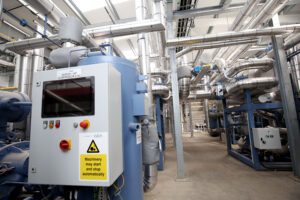GEA Group (Düsseldorf, Germany) has supplied heat pumps for district heating in Gateshead – the largest mine water project in the U.K. “Gateshead Mine Water Scheme” is currently the largest project in the UK for heat recovery from mine water. GEA as project partner supplied 2 x 3 MW high performance heat pumps. These heat pumps use the energy from naturally heated mine water to meet the heat demand of the buildings connected to the district heating network. The existing municipal heating network, which already supplies 18 public and private buildings and 350 households, will thus be expanded by an additional heat capacity of twelve GWh per year.

GEA supplies powerful heat pumps for district heating in Gateshead using mine water (Source: GEA)
Gateshead is located in the North East of England near Newcastle. Both Gateshead Council and its wholly owned business Gateshead Energy Company (GEC), as operator of the Gateshead District Energy Network (DEN), have committed to achieving zero carbon emission status by 2030. The mine water heat extraction system is part of Gateshead Council’s zero carbon heat strategy. The first goal was to provide cheaper heat energy for all residents in the borough. The second goal was to identify a supplement to the combined heat and power (CHP) system initially installed, and with a lower carbon footprint.
Councillor Martin Gannon, leader of Gateshead Council, says: “What is happening here is truly amazing. What we’re seeing in Gateshead is a legacy from the days of coal mines. Where we were a leader in the industrial revolution 200 years ago, we are now a leader in the clean energy revolution of today. Working alongside our partners, we can make use of the naturally heated mine water and generate valuable, low carbon energy. We are proud to have successfully delivered the largest mine water project in the UK.”
Richard Bond, director of innovation and engagement at the Coal Authority, added: “It’s fantastic to see forward thinking local authorities like Gateshead Council using warm mine water to provide low carbon heating for buildings. We have a low-carbon, secure, UK-owned heat source in the form of mine water in Gateshead, which is also an excellent option for many other coalfield communities. We are delighted that our support has helped make this project a reality.”
In the past, miners in Gateshead’s coal mine extracted black gold from the earth to fire blast furnaces, but also to heat homes. In fact, Gateshead was once the largest supplier of coal in the world, shipping more than 400,000 tons in 1625 to provide heat for homes. However, the last coal mines in the area closed in the 1960s. The tunnels have since filled with water – now the source of energy for the heat pumps. So once again, Gateshead’s underground provides vital energy for heating Gateshead’s homes and industry. This time it is being done in an environmentally friendly way, helping to reduce CO2 and NOx emissions.
The water is pumped from a depth of 150 meters from the old mine to the ground level plantroom where the 2 x 3 MW ammonia heat pumps from GEA, extract the energy from the mine water (15 degrees Celsius). The heat pumps boost the temperature of the extracted energy and hot water (80 degrees Celsius) is then provided to homes and buildings in Gateshead. When the heat from the mine water has been extracted by the heat pumps, the water is returned to the mine at a temperature of eight degrees.
To optimize the performance of the heat pump system with the 2 x 3 MW heat pumps, a two-stage compression cycle with screw compressors is used. Groundwater is filtered and pumped through titanium plate and frame heat exchangers. Titanium was chosen for the evaporator plates to match the quality of the groundwater. On the heating side, several heat exchangers are connected in series to optimize the efficiency of the heat pump solution.
Solar parks are also part of the concept – which help to provide some of the power to run the heat pumps – these have been newly built on a field next to the minewater boreholes and heat pump. For every 1 unit of power used by the heat pump, 3 units of renewable heat are generated. GEC will import power from the grid to run the heat pumps… which is decarbonising year on year and should be zero carbon by the middle of next decade. On sunny days, when GEC has surplus power from the solar parks, this will provide green power to run the heat pumps, meaning that for certain periods, GEC can produce 100% zero carbon heat now.
Ammonia was chosen as the natural refrigerant for this application. It offers the best efficiency and has no global warming potential. Under the given conditions in Gateshead, ammonia heat pumps are 10 to 20 percent more efficient than F-gas solutions (HFC/HFO).
GEA has been involved in other innovative heat pump projects for district heating in the UK in the past, including the installation of a heat pump that extracts heat from London Underground ventilation air and provides heat for a high-rise building in Islington.
John Burden, Director Project Sales Heating & Refrigeration Solutions at GEA UK, says: “GEA’s highly innovative heat pump technology has been used in other district heating projects in the UK and around the world as we recognize the dire consequences of global warming. Given the UK government’s ambitious targets to significantly increase the proportion of district heating in the UK, we expect to see many more new and ambitious projects in the coming years.”